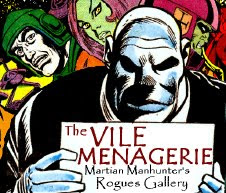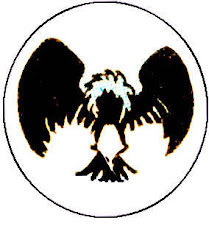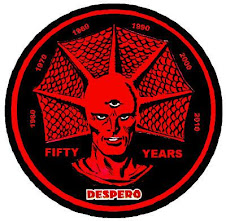 Forensic Psychiatrist Dr. Michael Stone's Scale of Evil Rank
Forensic Psychiatrist Dr. Michael Stone's Scale of Evil Rank
0)
Inapplicable.
Why Diabolu has been selected for 8th Place:
- Diabolu forever altered the original formulation of the Manhunter from Mars
The
John Jones strip originally centered around an alien stranded on our world who posed as a police detective to help ease the suffering crime caused his adopted Earth. Based out of Middletown, U.S.A., J’onn J’onzz initially fought a different human crook in each story, but once the public became aware of a Manhunter from Mars amongst them, J’onzz confronted more unusual threats. Jones’ primary support came from Captain Harding, the superior officer who doled out cases, and later policewoman Diane Meade, who was a sometimes partner and foil. Near the end of the almost decade long run of the strip in the back of
Detective Comics, a cute alien sidekick named Zook was added.
Meanwhile, by the end of the first appearance of the Idol-Head of Diabolu, John Jones was “dead,” the entire Middletown setting and cast were abandoned, the strip had been ousted from
Detective Comics, and the Martian Manhunter had his first ongoing villain. The relatively fresh arrival Zook was all that remained of J’onn J’onzz’s life prior to the touch of Diabolu. For years afterword, the strip was defined more by the monsters unleashed by the Idol-Head on a regular basis than by the actual lead characters.
- Diabolu “killed” John Jones.
It’s become de rigeur in comics for a hero to be forced to abandon one of their identities for a time, purely in service to dramatic effect. For years, Detective John Jones was the Clark Kent to the Manhunter’s Superman, and it seemed safe to assume this would always be so. Instead, a menace which had erupted from the Idol-Head attacked John Jones in front of witnesses, and destroyed the plausibility of J’onn J’onzz continuing in the role. As his former supporting cast wept for a fallen comrade, John Jones was left as dead for over twenty years.
- Diabolu was the Manhunter’s first ongoing menace.
Before the arrival of the Idol-Head, J’onn J’onzz had only fought one villain, Monty Moran, on more than a single occasion. It had been years since Moran’s second and final appearance when the Diabolu Idol-Head began troubling Manhunter nearly every issue for almost two years.
- Diabolu is the only long term menace to remain exclusive to the Martian Manhunter.
Professor Arnold Hugo was created to fight Batman and Robin, while most recently he turned up in a kiddie comic battling Aquaman and Superman. Malefic, Commander Blanx, and Mr. V all had run-ins with the Justice League early on. Even Bette Noir turned up in a
Harley Quinn story arc. As a consequence of there being so few villains to reappear in the Manhunter from Mars’ Silver Age solo series, and most of J’onzz’s enemies coming from team books later on, the Idol-Head of Diabolu is the only adversary to be exclusively engaged by Martian Manhunter and Zook.
- Diabolu was the de facto star of House of Mystery.
With Middletown left behind, the
Manhunter from Mars strip became about a pair of alien heroes trying to track down an arcane totem of evil. For better or worse, the Idol-Head defined the run to the point where, when sales were underwhelming and the device had to go, it took Martian Manhunter’s status as the cover feature with it.
- J’onn J’onzz destroyed the Idol-Head of Diabolu.
The death of Jean Grey helped launch the X-Men to the top of all super-hero franchises. The resurrection of Jean Grey a few years later left best-selling comics in its wake. Ever since, the impermanence of death and destruction has become the norm in comics. Further, Martian Manhunter has few enemies to call his own, and aside from his three year blip of a solo series, is mostly a glorified supporting player in team books. J’Onn J’Onzz is rarely in a role to definitively defeat anyone, but when the writing was on the wall regarding sales on
House of Mystery, another massive shift in the status quo was called for. Martian Manhunter finally located the Diabolu Idol-Head, learned its origins, then crushed it to bits with his bare hands. Once again, Diabolu signaled the end of an era for the Alien Atlas, and has remained untouched for nearly half a century. The destruction of the Idol-Head remains the Manhunter from Mars’ greatest and most lasting victory.
The Counter Argument:
- The Idol-Head isn’t a villain—it’s an knickknack. It’s your granny’s keepsake box turned sour. Lacking sentience and basic articulation, how bad must the Martian Manhunter suck to call this thing one of his greatest enemies? The Idol-Head is like Evan Dorkin’s four panel gag strip “Myron the Living Voodoo Doll,” except unfunny and less developed.
- The Diabolu stories were sub-literate garbage for slow children which barely functioned on dream logic. The Idol-Head stories killed the strip.
- Martian Manhunter never fought the Idol-Head, but instead the various monsters released from its captivity.
- Diabolu was the wizard that created the Idol-Head, not the object itself. That hunchbacked, loose toothed old fart only appeared in one story.
What Diabolu Represents:
The Idol-Head of Diabolu was basically a tool for completing the transition of the
Manhunter from Mars into a purely cynical generic comic strip.
House of Mystery was already a watered down and highly repetitive EC rip-off, but the Idol-Head was the engine to take it to its lowest level. At least in the anthology stories, bland characters were introduced to confront menaces with their own varied origins. Concurrently,
Manhunter from Mars was basically Superman in a cop uniform, but at least that was a hook. Brought together every month, the Idol-Head would spit out some weird threat, and the sole purpose for the existence of Martian Manhunter and Zook was to stop the dangers and try to find their implausibly mobile source. It was the boiling down of a concept to its most purely formulaic core. No need for personalities, locations, casts of characters, any sign of development, etc. Instant, soulless product—just add water and repeat as desired. The Diabolu Idol-Head is so vapid, its greatest accomplishment is to stand as the strongest evidence against the perceived value of the Martian Manhunter on record.
Analogies:
- The Idol-Head of Diabolu is to the Martian Manhunter as the Puzzle Box is to Hellraiser/Bottle City of Kandor is to Superman/Cosmic Cube is to Captain America/Random evil objects is to Friday the 13th: The Series
A MacGuffin. An object that is used to motivate certain types of stories.
In Closing:
The Idol-Head of Diabolu was a cheap tool to lure the Martian Manhunter into action, but it also effected some of the first and most devastating changes ever visited upon an established DC comic strip.































13 comments:
Another counter-argument:
John Jones didn't stay "dead". In the mid '80s, during the Justice League Detroit era, J'Onn resumed his John Jones identity. He claimed Jones had retired from the police force years ago. There was no reference to the Idol-Head having "killed" Jones. The "death" of John Jones, and possibly the entire Idol-Head saga, had been retconned. (Probably because writer Gerry Conway hadn't bothered to read DETECTIVE COMICS #326.) Although John Jones, now a private detective, doesn't appear with the same regularity that he did in the Silver Age DETECTIVE COMICS back-ups, and in recent years has been revealed to be but one of many secret identities assumed by the Martian Manhunter, John Jones is still alive and well.
In my unified theory of Martian Manhunter continuity, the "John Jones" service record submitted to Biloxi Investigations was for the version employed in Middleton, CO prior to and in the early days of the JLofA (see JLA: Year One.) The deceased John Jones of Detective Comics served in Middletown, New England in the 1950s and 60s. John Jones is a common enough name, after all.
No one else in the entire universe but you would make that distinction. Conway and every other writer since has assumed that the current John Jones and the Silver Age John Jones are the same guy.
NOPERS. Frank is not the only one with an inclusive theory of Manhunter history.
Superman and Batman, among others, are have not been allowed to grow past a certain point in a linear fashion. They are de-aged and rebooted to keep them safely relatable and popular, and any exploration that strays from the 25-35 age group is an "imaginary" story. There is some reason behind this, as innate familiarity (despite masks and capes, they are both "ideal" men) is part of their appeal, accentuating their fantastic elements all the more.
Martian Manhunter on the other hand has appeal rooted in his "other-ness" and so a decades long (centuries if you ask me or Grant Morrison) lifespan in real time is not such a bad thing. In fact, it's a bit of wish fulfillment in its own right. Being present for all the interesting things in the last 60 years is just a cool idea, let alone being a night invulnerable, shapeshifting demi-god.
So yeah, Jones is just a convenient alias, used a number of times over the decades, so non-Ostrander anachronisms are fine.
Ostrander's "there was a real John Jones" retcon, while not completely abhorrent, is up there with Greedo shooting first. Dumb and unnecessary.
As to the Idol-Head, as macguffin's go, it ain't half bad, and I will always think of it fondly.
This isn't about "an inclusive theory of Manhunter history". It's about whether the Idol-Head has lasting significance. Frank claims the Idol-Head is important because it forced the Martian Manhunter to give up his John Jones identity. But he hasn't given up his John Jones identity. John Jones is still around. Frank gives an arcane reason for believing that it's a different John Jones, but I doubt that anyone who has written a story with John Jones makes the same distinction Frank does. To the people who actually write the comics, there is only one John Jones.
You're right in saying that the John Jones personality is not fully formed, but just "a convenient alias, used a number of times over the decades". But that just makes the "killing" of Jones even less significant. Jones can "die" any number of times, then turn up later in another city. For all we know, the Idol-Head may not be Jones' first, or last, "murderer".
I'm not saying that the Idol-Head shouldn't be in the top 10. Frank gave all kinds of other excellent reasons for the Idol-Head's significance. I'm just saying that the failure of Jones to stay "dead" should have been included in the counter-arguments.
Ah, but you are forgetting the time length involved. Frank can answer better than I, but I'm pretty sure from the Death of John Jones in 1964 until the early eighties he was quite "dead." The Idol-Head was the impetus for this sea change.
Tom, regardless of DC's ever shifting and constantly contradictory continuity, the John Jones character was killed off in 1964. Jones made no new appearances after his demise until he was given a soft revival in 1984, and firmly resurrected in 1986.
Whatever arbitrary dictates this writer or that imposes, the comics were printed and the stories stand. Every time some editor tries to lay down a new law, the next guy overturns or ignores whatever they don't like or never bothered to research. Between the Human Flame and Zook turning up in Didio era comics, it's pretty clear the general exclusion of Silver/Bronze Age solo stories that began with the 1988 Martian Manhunter mini-series is no longer entirely binding. If the original Idol-Head story "happened," then any retcon someone makes up has to compete with Diabolu having beaten them to the punch by nearly fifty years, and had an effect on twenty years of publishing history.
Um... I guess I shouldn't have stopped mid-reply to watch movies with my girlfriend, or I'd have given a nod to M.C.'s faith in my myopia...
While this is complicated to the point of headache-inducing, and I really don't want to hurt anyone's feelings, but I figure I might as well throw my hat into the ring just for the heck of it.
I'm kind of seeing it both ways--yes, it was important that John Jones got "killed" off, but at the same time, I don't see the Idol Head being all that important mostly for Frank's counter-argument that the Idol-Head stories were "sub-literate." They were rather contrived and formulaic, and I wouldn't even put the Idol-Head on "Maguffin" level, because a Maguffin implies misdirection towards a broader story goal (in the Hitchcockian sense of the term) and there's none of that subtletly in any Idol-Head story that I can think of.
Anywho...my main beef with the killing of John Jones not being not that important to comicsdom is because I see it as plot device the writers employed while they transitioned from 'Tec to HoM. I don't think they were thinking of breaking comics precendent or making history, but merely trying to solve the problem of "how do we keep our creation going in a different type of book?" Therefore, in my mind, the death of John Jones isn't a creative victory but just a storytelling convenience.
Sure, it is somewhat important that a main character's alias get killed off...but it's not on the level of Janet Leigh dying only a third of the way into Psycho.
Also, just to provide backup to Tom's counter-argument of Frank's defense of his argument that there is more than one John Jones...why would an alien of pretty high intelligence choose the same obviously-fake name twice in his lifetime, especially after living with humans for however many years? I think it would be time to bust out "Adrian Swiatowitz" or something by then.
No worries... you and me, you know we're always tight.
Liss, there are only two finds of comments that hurt my feeling: outright nasty ones, and no comments at all. I made controversial choices/assertions, so I expected some debate would follow, and wouldn't have it any other way.
I expect you're right about the reformating of J'onn J'onzz between books, but I disagree that history wasn't made in the process. In the rare instances someone was actually trying to make history in comics before the 1970s, you ended up with weird political vehicles like Wonder Woman that struggle to pass the smell test. The rest of the time, creations just fell ass backwards into notoriety.
Finally, how can logic be expected from J'onn J'onzz? The guy ran around with super breath but couldn't blow out a match. Scipio had a field day with J'onn's illogical actions. If anything, I think "John Jones" is a front-- an identity tailor made to be the one people find out to protect his others. If Vandal Savage knows who John is, and the identity continues to be used, something is up.
I think Frank is on to something here. In the recent Madame Xanadu appearances (read em if you haven't, they're fun) He introduces himself as simply "Mr. Jones." It is clearly an alias, and really, in a sixties detective/occult story, not out of the ordinary...at least until he starts lifting houses and taking gut shots without a scratch.
I think that the Idol-Head did make some changes for J'Onn J'Onzz in that he had to abandon an identity. Yes, many of the stories of that era were sub-stellar.
I really don't think the Idol Head qualifies as a villain as a nasty headache.
As for the multiple identity, perhaps a few people are in the know. Also, maybe J'Onn will be working with a few alternate identities. (If Vandal Savage knows about one, retire it and create some others.)
Post a Comment